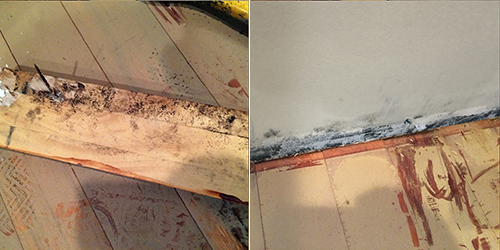Presented here below you can get a good deal of superb facts on the subject of How to Fix a Water Damage Bathroom.

The bathroom is exceptionally at risk for damp build-up as well as potential water damage due to the regular use of water in it. This short article provides simple inspection strategies to assist detecting water damage hazards.
The constant use of water in the bathroom makes it exceptionally vulnerable for wet build-up and possible water damage. By inspecting it on a regular basis, you can reduce water relevant damages.
The complying with collection of assessments is easy to execute as well as need to be done when in every 3 months in order to keep your washroom healthy and to avoid potential water problems caused by the bath tub, the shower, pipe joints and also plumbing, sinks, cabinets, and also the toilet
Do not forget carrying out these examinations as well as be detailed while doing them. Remember that these easy examinations can save you a great deal of money by supplying early indicators for water damages
Tub and also Shower
The shower and tub call for special focus and maintenance. Examine the tiles as well as change if broken. See to it that there is no missing grout in between the tiles. Check and also replace split caulking at joints where the wall surfaces satisfy the flooring or the bathtub. Blocked drains as well as pipelines problems will certainly prevent the tub from drying as well as might indicate severe problems below the bath tub. Speak with a specialist immediately to avoid architectural damage. Focus on stainings or soft areas around the tub wall surfaces as they may suggest an inner leak.
Plumbing
Signs for water damage are difficult to find since many pipes are mounted inside the wall surfaces.
Pay unique focus to floor covering and also walls moisture and spots as they might suggest an unseen plumbing trouble. Check moisture levels in adjoining spaces also.
Sinks as well as Cabinets
Sinks and also closets are revealed to dampness and humidity daily and are usually overlooked. Inspect routinely under the sink and on the countertop above it. Repair any drip in the trap as it may recommend drain problems. Look around the sink, slow draining pipes may indicate a blocked drainpipe. Change sink seals if they are split or loosened.
The Commode
The commode is a vulnerable water junction. Check the water lines and search for leaks around the bathroom seat, in the hose pipe, as well as under the water storage tank. If you find any kind of indicators of dampness on the flooring around the commode, look for leakages in the toilet edge as well as storage tank seals.
Know that hanging bathroom dish antiperspirants boosts the possibilities for blockages.
Water Damage Signs In The Bathroom To Avoid Cleanup
Musty smell
This is one of the easiest signs to catch because musty smells are so odorous. The damp, earthy, moldy smell should be a big red flag. The smell will develop when moisture gets trapped in surfaces, and begins to facilitate mold growth. Leaking pipes under cabinets, inside walls, and behind shower fixtures will cause moisture to stay trapped and not dry, which will lead to mold growth and spread. As soon as you notice any musty smells in your bathroom, have it checked for hidden water damage and cleanup signs.
Visible mold
If the smell isn’t there to give it away, sometimes you will actually see mold growth. Finding mold in your bathroom is a serious problem, because mold is very harmful to your health. By the time mold growth is visible, it also means that water damage has already occurred and been present for some time. The only way the mold problem can be resolved is to find the source of the moisture and get it stopped. To safely and adequately remove mold, you need to have professionals handle the remediation. Do not waste any time in getting mold problems addressed, fixed, and sanitized so that you can protect you and your family from the many respiratory symptoms caused by mold exposure.
Damaged floors
Bathroom floors should be able to withstand some exposure to water while still remaining in good condition. However, when excess exposure or water leaks occur, they will begin to damage even the most water-resistant flooring. If you notice any cracking, bubbling, staining, or warping on your bathroom floors, there is probably a water leak somewhere causing the distortion. If you notice areas of the floor have become softer, or even have a spongy feeling, there is probably damage to the subfloor. Subflooring is typically made up of plywood. When plywood is exposed to water or moisture, it will absorb it. Once it has become saturated, the weight of the excess water will cause the wood to swell and soften. Check the floors in your bathroom frequently to catch any of these sings before they lead to damaged subflooring.
Changes on walls
When water leaks behind walls, it will cause changes in the drywall. Peeling plaster, blistering paint, and soggy wallpaper are all good indicators that excess water is building up behind the wall. Water leaking behind drywall will cause it to swell and be soft to the tough. If you start to notice gaps along the trim of your walls, or where tile meets the wall, it could also be a strong indicator that there is a leak behind the wall. Any changes, distortion, or damage on the walls should be evaluated as soon as you notice it to prevent further water damage and cleanup.

As an enthusiastic person who reads about How to Prevent Bathroom Water Damage, I imagined sharing that piece was essential. Sharing is good. You won't know, you will be helping someone out. Bless you for your time. Don't forget to check our website back soon.
Course Detail